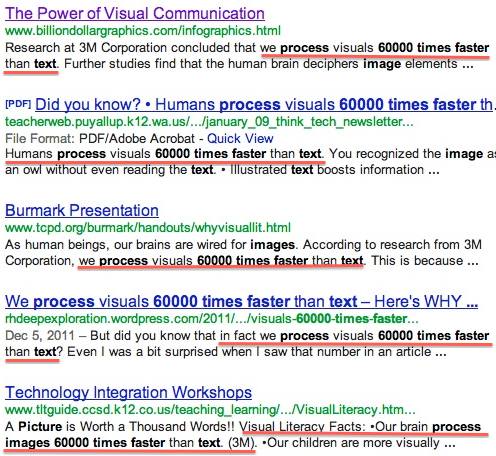I’m trying to be the relentless dog who will not drop the bone. Believe it, you cannot find everything on the web, and in this case, what I find on the web is something repeated so much, that people accept it as truth.
I am calling agents of information literacy to help me find the grail.
Back in May I wrote about trying to locate the source of a statement that is repeated so much, I had heard it, and accepted it as something that somewhere had a research basis- it is some variation of:
Research at 3M Corporation concluded that we process visuals 60000 times faster than text.
Go ahead, google jockeys, see if you can get anything beyond this:

I traced this back to a PDF published at 3M (on a web page that exists now only in the internet archive, everyone stop and bow in honor towards the archive), where the only citation reference reads:
Did you know that visual aids have been found to improve learning by up to 400 percent? Did you realize that we can process visuals 60,000 times faster than text? Would you guess that the average person only remembers about a fifth of what they hear?
These findings from behavioral research confirm our daily experience: we rely on all our senses to bring ideas and concepts to life.
(my emphasis added) That is it- the basis for this oft repeated assertion is usually cited as 3M, and the reference there is the vague, “These findings from behavioral research” — Where is this research? Where? Where?
I’ve asked a few librarians, who dug, but found no bone. I contacted 3M through their contact form, and very nice lady named Mary responded and we went back and forth. She wrote a month later and said there was someone in the office that had the answer in a document, and she would send it when this person returned from vacation.
I thought I was close!
The document she sent me?
It was that same PDF I found on the web myself.
I cannot let this go. There is a lesson to be learned here about what is fact and what appears to be fact by sheer repetition. I fully believe there is a research paper somewhere that supports this assertion, though I actually seriously doubt the hard fact of the 60,000 times number.
So how do I make this happen? I am going to post it to Snopes.com. I will tweet it out. I will email some more librarians. I will try the strength of my weak ties. Maybe I will offer money?
I cannot let go of this.
I won’t.
Help me?
Here’s the deal. I don’t have 60,000 bones in the bank- but I will put fur in the game– I will pay the first person to send me the source of this research $60.00! I am asking not only for the citation, but the research paper itself or at least the content.
How many more cute dog pictures will it take?
UPDATE: July 7, 2012 A great flurry activity of response to this post and a round of direct emails to colleagues. The $60 prize awaits.
A number of people sent me the link for the Polishing Presentations document (2001) that is usually cited in publications. As I have blogged about the frist time around – this is not a credible reference since it only parrots the assertion and mentions it as “findings from behavioral research”.
Several people pointed me to what looks like related research from the University of Minnesota published in 1986 as Persuasion and the Role of Visual Presentation Support: The UM/3M Study maybe the first was a tweet from Karla Cross who later suggested tracking down the lead author, Doug Vogel
And Doug did respond to my email request and replied:
<br>The research that I did as a PhD student at the U. of Minnesota was involved with persuasion and the working paper that you found is actually the most complete description of the work (even beyond that which was ultimatedly reported in my thesis). I have not seen the 2001 3M publication but my research had nothing to do with visual processing speed.cheers,
doug
<br>
This paper alone opens another worm hole to explore, its often repeated conclusion:
Presentations using visual aids were found to be 43% MORE PERSUASIVE than unaided presentations.
Can the original research, which was tightly bound around a study of graduate students responding to a pitch for a seminar presented to them in VHS and overhead transparencies and measuring how many of them signed up, really be this globally extended as a “fact”? I dont question the original work, but again, once something gets repeated… well, there you go, again.
If anyone is close to the prize, it is Darren Kuropatwa who went to the extremes in his research (and introduced me to the interesting search tool http://millionshort.com/ which performs searches after stripping out the most popular sources so you can zero in on the obscure…
Darren unearths notes form a presentation by Jenn Manalo, Sr. Product Specialist, 3M Corp. (31 August 1998) where she repeats the magic chorus:
So good visuals benefit not only the audience but the organization and presenter as well. This is because of increased productivity and effectiveness, enhanced professional image of the presenter, and a generally more attentive audience.
“Humans can process an outstanding amount of visual information. Actually, we can process at 60,000 times faster than text.”
Before you get too excited, she also cites the Vogel et al paper above but includes the faulted re-iteration (emphasized below) of Dale’s Cone of Experienced
In creating effective presentations, we all know visuals can be of great assistance. According to research findings, visual aids help increase persuasiveness of presentations by as much as 43%. People remember 10% of what they read, 20% of what they hear, 30% of what they see, and 50% of what they see and hear. Furthermore, the use of colors can accelerate learning, retention, and recall by 55% to 73%; increase comprehension by up to 73%; and sell (products and ideas) more effectively by 50% to 85%.
UPDATE: July 7 (later in the day!): I’ve been spraying the request everywhere, Google+, LinkedIn, even (ew), Facebook.
Emails have been send to Dennis Profitt as well as speaker/author Lynnell Burmark, who publishes this statement and uses the 60000 statement on her web site.
Just in! A reply from Dennis Proffit at UVA who suggests the processing time of visual and text information should be about the same:
<br>
Hum"¦ This seems an odd claim. The minimal time required to identify whether an animal is present in a natural scene is 150ms. See:<br>
<a href="http://www.mitpressjournals.org/doi/abs/10.1162/089892901564234">http://www.mitpressjournals.org/doi/abs/10.1162/089892901564234</a>
This is about the time required to identify a letter or a very familiar word.
I suspect the claim is a deduction from physiology. Text is processed in central vision, and thus, engages fewer photoreceptors than do pictures. One might argue that the recognition process for reading goes a bit deeper into association areas in the temporal lobe than does pattern recognition. But, based upon what I know from behavioral research, the comparison does not make much sense. Both picture and text processing vary with the familiarity with and complexity of the presented material, making direct comparison hard.<br>
I also located vis LinkedIN (first time I used it to locate a contact) Carlos Abler, a research and content strategist at 3M. I was not going to pay for LinkedIn’s internal email thing, but I sent a tweet:
UPDATE (July 27, 2012): No winners. People keep emailing me the link to the 3M PDF brochure on Polishing Your Presentations which I’ve already clearly stated above is not a credible citation since it merely repeats the claim w/o citing the research.
Via a comment on Darren Kuropatawa’s post from Wesley Fryer, I got in touch with Obi Wan Bernie Dodge, who knocked down this claim a few clicks back (and perhaps it was the back of the envelope calculation on nerve transmission speed that produced the 60,000 number?)
Featured Image:




I understand but was worth a try. Alan, on a separate note, what does your experience and knowledge say about the other stat that “90% of the information transmitted to the brain is visual”? I ask that as I also hope that we can verify this?
“90% of the information transmitted to the brain is visual” just smells like one of these flowery generalizations that you might drill for long periods without finding something that clear cites research basis.
I can see problems just in the wording — what exactly is meant by “information”? How do you quantify it as a percentage? What is the measure? How do you define information as visual? It’s all nerve impulses. I imagine there is something that gets to these from misual of the parts of the cortex known to process what the eyes see,
That I found it lumped together with the 60,000 times claim under one of these web sites offering expertise in visual effectiveness has that foul odor- see item 2 here https://www.shiftelearning.com/blog/bid/350326/studies-confirm-the-power-of-visuals-in-elearning The “source” link is a dead domain.
The task is to trace the cited sources upstream, and often you end up with the source being some other learning consultant. It might be fun to chase, but you know, only so many hours in a day for shooting down the bad info on the net.
I don’t know if they are still active but the Debunker Club was active for while shooting these fish in the barrel https://debunker.club/
Chase it and report back!
In a clear representation of the beauty of the internet, and as a characteristic of memes where they regenerate, replicate and mutate, I have been brought here after I stumbled upon the “60,000 times faster than text” quote in an article (https://www.inc.com/rhett-power/how-ai-machine-learning-can-help-build-a-more-engaged-workforce.html) based on an e-learning material from an LXP called “Degreed” (https://get.degreed.com). The article, proudly, presented the infamous 3M page as the source of the info (http://web.archive.org/web/20001014041642/http:/www.3m.com:80/meetingnetwork/files/meetingguide_pres.pdf).
At the beginning I was amazed by the info and I wanted to share such find in my professional group chat but little-by-little I started to think “the 60,000 is too big of a number to be true”. Considering that the average visual processing capability for humans is 150ms, 60,000 would mean that we will take around 2.5 hours to process text comparing to an image which is unrealistic.
As of today, the number of pages in the internet (according to Google) that is showing the exact wording “60,000 times faster than text” is 20,000 pages. Without using the the quotes function the number shoots up to over 9,200,000.
Hello Ashraf, I applaud you for going the extra step to dig into the claim before doing with 60,000,000 of the internet does (made up number) and reshares without checking.
And look, in the blaze of fluff about AI, another reporter at Inc. just glibly keeps the myth alive. They have no means to counter with a comment.
Keep on questioning! Thank you
It’s such a nice and visual number and so catchy. Your research is funny and important but it’s so sad that there is no result. Now, I have to find a different fun fact for my workshop. 😀
You can always use as it sounds so true! See if anyone questions it 😉